In Old Theatres, Some See Hope For Renewal
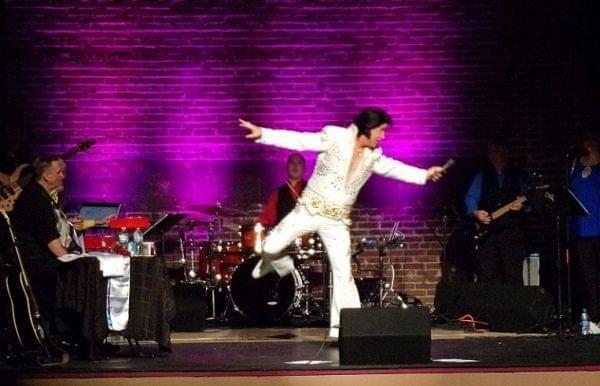
Elvis tribute artist Doug Church performs in August at the Lorraine Theatre, Hoopeston, Illinois. Save The Lorraine Foundation
Across the country, local residents are working to restore rundown theatres to their old luster, often with the hope that their community will benefit as well.
This article looks at efforts to revive theaters in Hoopeston and Champaign, but there are similar cases across the country as well as Illinois.
Hoopeston: New Life For The Lorraine
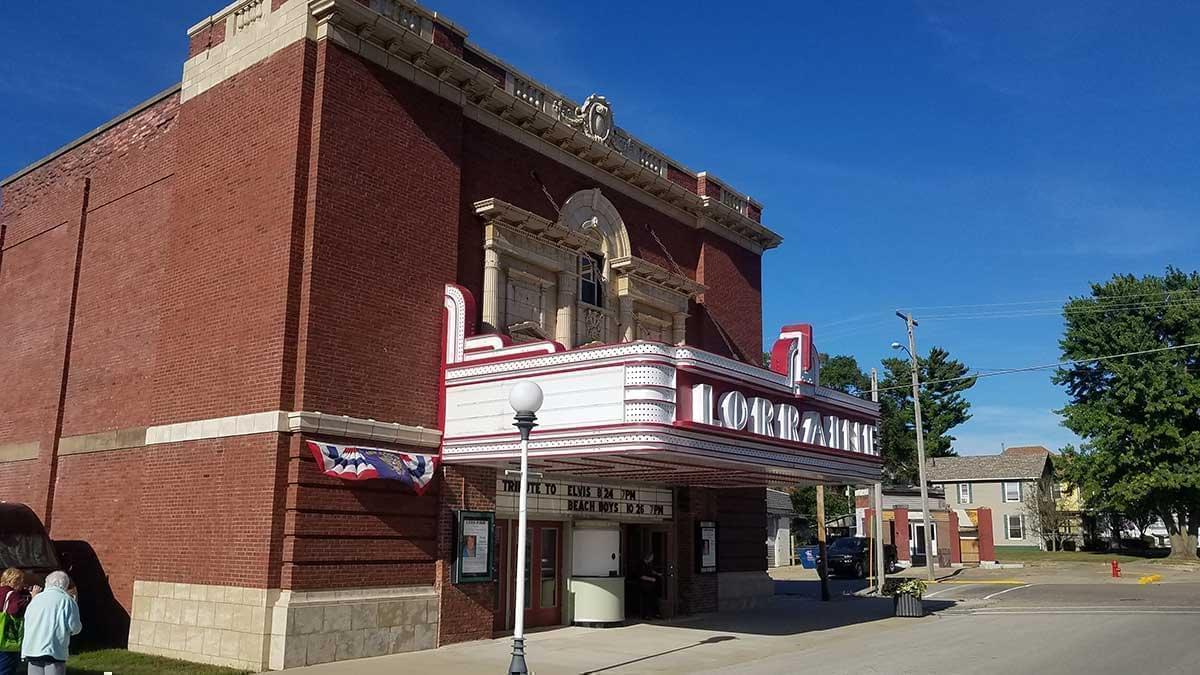
The Lorraine, located on Main Street in downtown Lorraine, operated as a movie theatre from 1922 to 2012. Today, the Save The Lorraine Foundation operates the theatre as a multi-use venue, and is continuing its restoration.
Hoopeston is a small town north of Danville that’s known for its canning industry, although both the industry and the town (with a population of around 5,351 in 2010) are smaller than they used to be. On a Saturday night in August, downtown Hoopeston’s Main Street is quiet, with few businesses open. But at the Lorraine Theatre, Elvis is in the building.
Inside the theatre, Doug Church, who bills himself as “the true voice of Elvis”, steps on stage in a bejeweled white suit, similar to the ones Elvis Presley wore while performing in the second half of his career. He sings the King’s biggest hits, from “Blue Suede Shoes” to “Burning Love”. An assistant hands Church a succession of scarves, which he drapes around his neck before handing to women in the front row. There are several empty seats in the 300-seat Lorraine Theatre during Church’s concert, but the audience is enthusiastic, and sends him off with a standing ovation.
Doug Church is a professional entertainer, but the people running the Lorraine Theatre are all volunteers with no prior experience in running a theater. That includes Alex Houmes, who ran lights for the concert, including some newly-installed moving head spotlights that he had just figured out how to use.
“We’re constantly evolving and learning from what we’ve done previously,” said Houmes. “Because none of us have theater experience, we just all love the theater, and we all love our community. And we’re just basically doing the best we can, right? And learning as we’re going. And we’ve learned quite a lot and come a long ways.”
Houmes is on the board of the Save The Lorraine Foundation. A group of Hoopeston residents formed the non-profit group in 2012, when the Lorraine Theatre closed down, a victim of changes in the movie industry, and Hoopeston’s declining population. A local benefactor, Fontella Fraley Krout, bought the theatre, which had gone into receivership, and turned it over to the foundation. The Save The Lorraine Foundation launched its restoration work at the Lorraine in 2014. They've been at it ever since, as funding and manpower allows. Retired high school teacher Jim Richards is the board president.
“We were not known citizens of the community,” said Richards of the Save The Lorraine Foundation’s work. “We weren’t on the city council. We weren’t the affluent people of the city, just a group of people that cared about the Lorraine that got together. And we met right out here in front of the Lorraine in the lobby.”
(Actually, since the Save The Lorraine Foundation got started, board member Alex Houmes has been elected to the Hoopeston City Council.)
The Save The Lorraine Foundation has made extensive repairs to the 98-year-old theatre over the years, including tuck-pointing, repairing a ceiling that had partially collapsed, refurbishing the marquee sign and taking the first steps towards restoring the art deco interior that was added to the Lorraine during a major renovation in 1937.
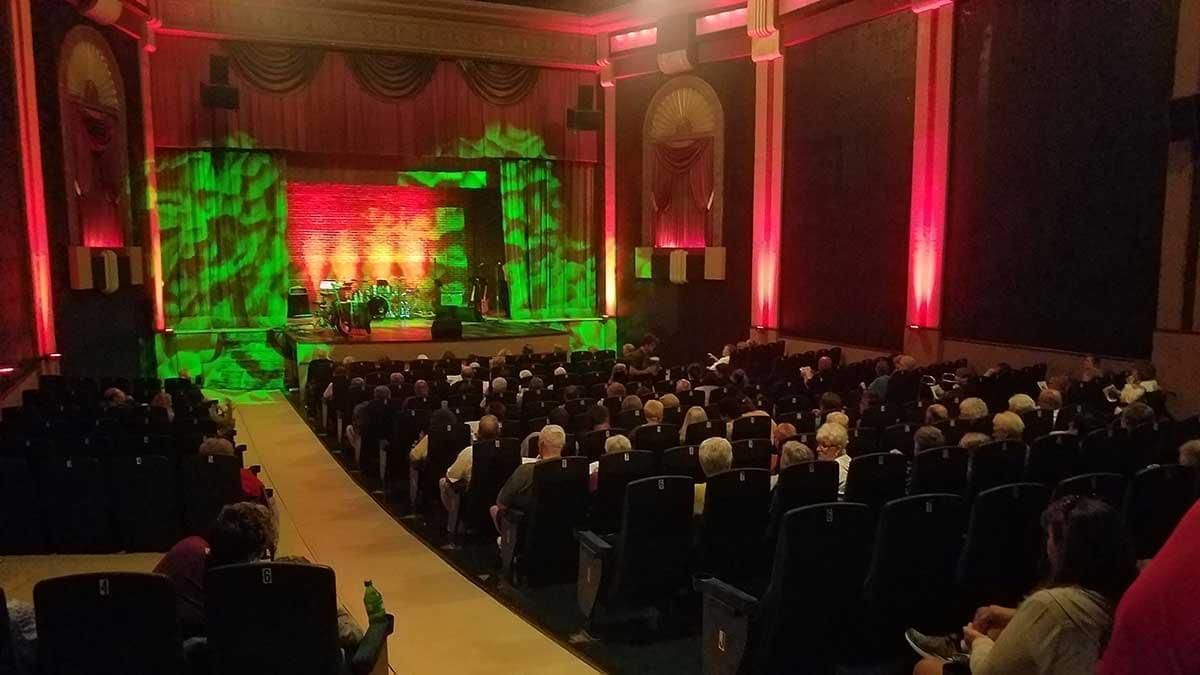
The audience awaits the appearance of Doug Church, “the True Voice of Elvis,” at the Lorraine Theatre in Hoopeston.
The Lorraine’s restoration is a work in progress. But board member Marilyn Tyler says what they’ve done so far brings back memories, of going to the Lorraine on dates with her future first husband, when he was a projectionist there.
“It’s even cooler when the lights are all on, when it gets dark and you see the lights on the street that haven’t been here for years,” said Tyler from behind the concession stand she staffed during the Doug Church concert. “We almost get teary-eyed when you see it like it was when we were kids.”
Besides tributes to Elvis (the recent Doug Church concert was his third at the Lorraine), the revived Lorraine Theatre has hosted local events ranging from school board candidate forums to the Miss Hoopeston pageant, as well as private functions like weddings. Bringing movies back to the Lorraine remains a goal, but an expensive one, due to the cost of today’s digital movie projection systems. Instead, the Save the Lorraine Foundation is showing movies down the street.
Friday nights are “Pizza and a Movie” night at the Little Lorraine. The pizza comes from a nearby restaurant, and and on a recent Friday night, the movie was “How to Train Your Dragon 2”, projected from a DVD. The Little Lorraine is a 48-seat storefront theatre established opened about 20 years ago during the Lorraine’s days as a commercial movie theatre. It provided a second screen so that the Lorraine could meet contractual obligations to continue showing movies that didn't draw customers as hoped. Right now (except for an August-September break for renovations, including risers for the back rows of seats) the Little Lorraine is Hoopeston’s only regularly operating movie theater.
Save The Lorraine board member Alex Houmes says he the weekend movies at the Little Lorraine (along with a well-attended monthly trivia night) and the live shows every month or so in the main theater have brought a spark of life to downtown Hoopeston. And he thinks they’ve played a role in encouraging other businesses that have recently opened downtown.
Board president Jim Richards sees another benefit. He’s been moved by Lorraine Theatre concerts that involve local people, like a Christian music concert in May that featured performers from local churches.
“And it’s just a miracle, what you hear coming from them,” said Richards. “The music and the songs and the spirit. And I just think this theatre just gives love back to ‘em. You can just feel the vibes from ‘em when they’re on the stage. And it just brings the best of them out.”
Not every concert and movie at the Lorraine makes money. In addition to theater revenue, the Save The Lorraine Foundation relies on grants, local donations and fundraising events (including a Scavenger Hunt scheduled for September 14) to keep its theatres open. The next big show at the Lorraine Theatre is a Beach Boys tribute band in October.
Champaign: The Virginia Theatre, Transformed
The music of its Wurlitzer pipe organ is one of the things many people remember about the Virginia Theatre. The organ, which once accompanied silent movies, is still used today to charm audiences as they come in for shows at the vintage theater in downtown Champaign.
For Jim Barham, the Virginia brings back memories of a downtown Champaign that used to be home to several theatres --- the Orpheum, the Rialto, the Art and the Illini, as well as the Virginia. Barham remembers the Virginia’s Saturday matinees, which he and his childhood friends frequently attended --- or more precisely, snuck into through an emergency exit.
“You’d climb up the stairs, which is the fire escape,” Barham remembered. “And so one person would buy a ticket, but you had to be careful in the afternoon, because the sun would come in. One person would just get the door open, slightly, and we’d all just bust in and go separate ways. We were much more successful than not.”
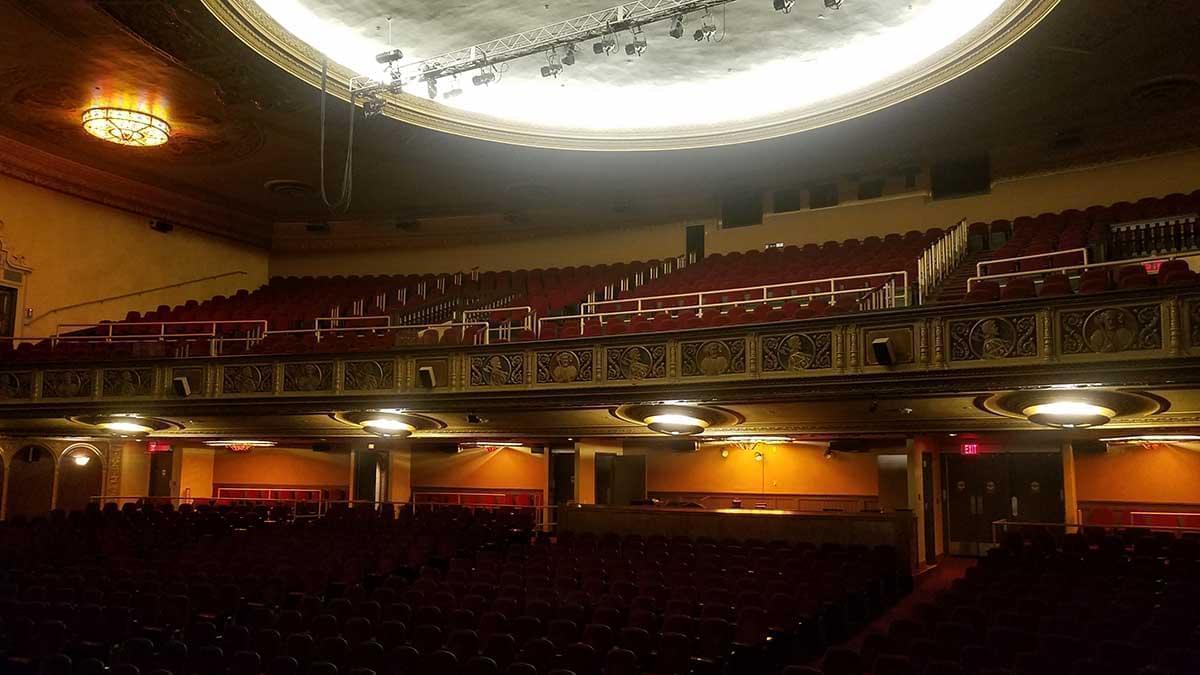
View of the Virginia Theatre, showing the mezzanine and balcony.
That was back when the Virginia was still a profitable movie house. As movie attendance declined, the Virginia was reinvented by new managers as a live performance venue for the 1990’s. One of its regular tenants --- and later a co-owner with another non-profit created with city backing --- was the Champaign-Urbana Theatre Company. CUTC was a community theatre group formed expressly by supporters of the Virginia, to produce musicals in the old theater, and keep it active and in the public eye. Founding member Jeff Goldberg says their first big production, “The Music Man”, drew more than 5,000 people to the Virginia during its run in 1992.
“I’ll never forget, when opening night at the first ‘Music Man’, there were these older people, telling us stories about the first time they came to the Virginia Theatre, in the ‘30’s and ‘40’s. ‘We’re so glad it’s still going on (they said). Keep going, keep doing this.’
The Virginia is a big, ornate theatre, with seating for about 1,500 in its heyday, decorated in an Italian Renaissance style on the outside, and a Spanish Renaissance style inside. It was designed to present both movies and live performances. Its opening attraction in 1921 was a touring production of “The Bat” an “old dark house” comedy-mystery that was a megahit in its day. In the 1930’s, the Virginia was leased to the RKO theater chain, and included vaudeville acts along with movies.
But by the 1990’s, the Virginia was deteriorating, with a rusted-out marquee sign, water in the basement and damage to the theater’s interior plaster work, due to a leaky roof.
Steven Bentz, the Virginia’s current director, says there was an incident during an Alice Cooper rock concert in the early 2000’s, “when large chunks of plaster fell from the proscenium arch during the performance --- you know, the bass response --- and landed on the stage next to some of the artists. Those stories tend to last for a long time and take on kind of the quality of myth. And I think when people come in here now, they can’t believe their eyes. It just looks perfect.”
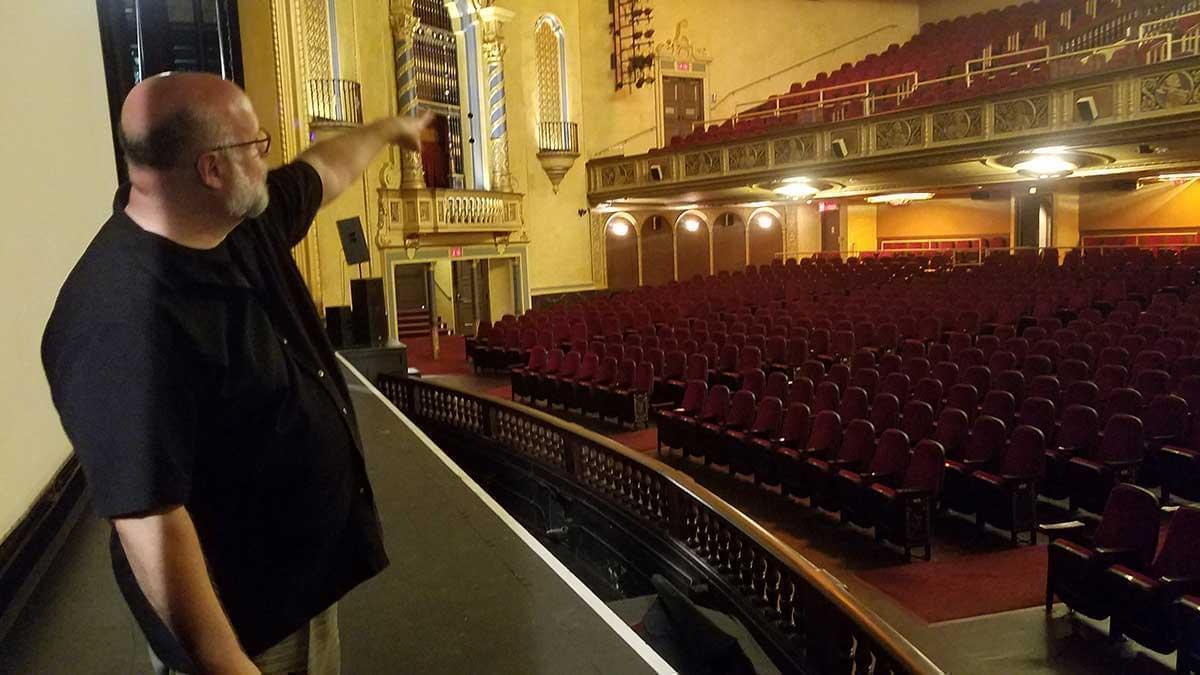
Virginia Theatre Director Stephen Bentz stands on the theatre’s stage, pointing out a detail of its Spanish Renaissance interior.
The Virginia looks good now, thanks to extensive renovations, overseen by the Champaign Park District, which took over the theatre in 2000. By that time, Jim Barham, who used to sneak into the Virginia to watch matinees as a kid, was a commissioner on the Champaign Park Board, sharing the responsibility for the theatre’s future. Despite the building’s poor condition, he credits the Champaign-Urbana Theatre Company with helping to preserve it.
“It was a mess, the roof was leaking,” said Barham of the Virginia’s condition when the park district took over. “But to their credit, the Virginia would not be standing here today, without what they did, the CUTC. They kept the power on. You know, if that hadn’t been heated, and the power (kept) on, and people coming in and out, the building wouldn’t have been here.”
One of the last projects of the old Virginia management was an application for state funding for urgent life-safety work. That was the start of more than a decade of major repairs and improvements, running into the millions of dollars. It culminated in an interior renovation that closed the Virginia for several months in 2012-13, when the theater auditorium was restored to nearly what it had been when the theater opened in 1921.
To complement the restoration work, the Champaign Park District has beefed up the Virginia’s schedule of shows and events. Today, the Virginia Theatre is busy about 200 nights a year, with community performances, touring artists … and a year-round movie schedule, including the annual Ebertfest in April. The film festival was launched in 1999 by the late film critic and Champaign-Urbana native Roger Ebert, and has continued past his death in 2013. A statue of Ebert, seated in a row of theater seats and giving his well-known thumbs-up gesture, is located in front of the Virginia Theatre building.
Champaign Park District executive director Joe DeLuce says he believes the Virginia Theatre’s revival has also helped revive downtown Champaign, and helping it make the transition from a 20th century shopping district to a 21st century entertainment hub.
“With people coming down for dinners and different events going on here, we think that this has really been one of the cornerstones that really have helped made the downtown business so successful,” said DeLuce.
The Virginia Theatre’s renovation was paid for with grants and major donations, park district tax revenue, and a continuous community fundraising campaign. A new concert-quality sound system is the next major upgrade on the Virginia’s schedule, as the Champaign Park District hopes to keep it a cornerstone of downtown for years to come.
Got An Old Theater?
Other theatres in Illinois that have been championed by non-profit groups and governments include the Fischer Theatre in Danville, the Orpheum and Art Theatres in Champaign, the Normal Theater in Normal, the Homer Opera House in Homer, the Varsity Center in Carbondale, the Egyptian Theatre in DeKalb, the Coronado Performing Arts Center in Rockford and the Rialto Square Theatre in Joliet. Some of these are still in the early stages of renovation, while others have been fully restored.
Most of these theaters have one thing in common: elaborate, even over-the-top architecture and interiors that identify them as shrines to entertainment.
Historical architect Craig Morrison says people are drawn to old theaters by the “exuberance” in their design.
“I like the way they brought people together and brought joy to their communities,” said Morrison, who serves on the board of the Theatre Historical Society of America. “Their users know they had a purpose, that even though they were designed to be money-making, they went beyond it. There was a kind of spirituality there, too, besides just the crass commercialism.”
I like the way they (theaters) brought people together and brought joy to their communities."Craig Morrison, Theatre Historical Society of America
While there are old theaters still being run as businesses, Morrison says most of the ones operating today are run by non-profits, many of which he’s worked with. He says there’s not much money to be made in reopening an old theater, but working with the groups that give it a try has been a rewarding experience for him.
“They get together, they try to raise money, they question, ‘are we doing the right thing?’” said Morrison. “’You know, there’s a theater in the next town; should we really be restoring this?’ And I always tell them, hey, you’re restoring an old theater and you got a nice little theater. Restore a dozen of them, you’ve got Broadway.”
But Jeff Goldberg, who helped manage the Virginia Theatre as a founding member of the Champaign-Urbana Theatre Company, says having adequate financing to address problems is key for any group that wants to try to revive an old theater building.
“My recommendation would be, if you can’t afford to hire a development officer, find somebody who’s willing to raise money,” said Goldberg. “You’ve got to start with money.”
Goldberg said in the case of CUTC, they started off with talented creative staff who were willing to work hard for very little pay. “What we were weak at was finding money”, he said.
Links
- Hoopeston Group Looks To Save Lorraine Theater
- Historic Virginia Theatre Opens For Public Tours
- 90-Year-Old Organ Restored at The Virginia Theatre
- New Virginia Theater Marquee Goes Up
- Champaign’s Virginia Theater Receives State Grant for Additional Rehab
- Renovation Bringing Danville’s Fischer Theatre Back To Life
- Virginia Theatre website
- Lorraine Theatre website

